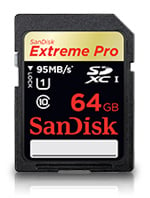
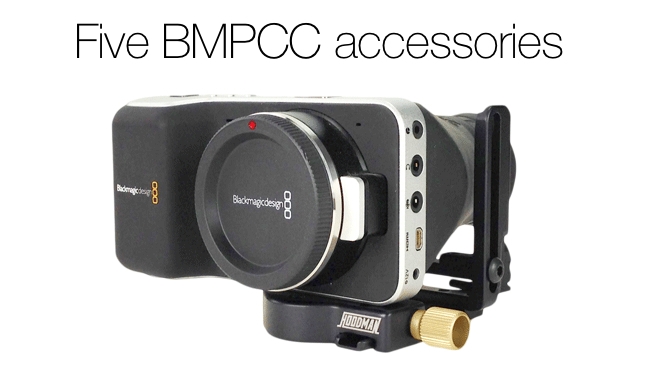 Hoodman Finder and Blackmagic Pocket Cinema Camera
Hoodman Finder and Blackmagic Pocket Cinema Camera
Here are some pretty essential accessories for your Blackmagic Pocket Cinema Camera
The Blackmagic Pocket Cinema Camera is finding its way into all sorts of production workflows. Its small size, coupled with the high latitude recording into RAW or 10bit ProResHQ, make it a highly versatile piece of gear. However, when you pack a camera into this form factor and price, there are things that you have to compromise on. In addition to a lens of course, there are some additional things you have to purchase in order to make this camera production ready. Below is a list of five essential pieces of kit you’re going to need for your Blackmagic Pocket Cinema Camera.
1. External Audio Recorder and Microphones
The lackluster audio circuitry and internal microphone, coupled with extremely limited audio controls make the Blackmagic Pocket Cinema Camera cry out for a more professional audio solution. While its always been preferred to shoot with a dedicated audio recorder and external microphones with any camera, the questionable audio on the BMPCC pretty much demands that you do this. There are several options depending on your needs from the low end Zoom H6, Tascam DR-60D, to the higher end Sound Devices Recorders. External microphones are a must too, with shotgun mics, or wireless lavs being the leading candidates for field production. Even the lowest end dedicated audio gear will still give you a magnitude better audio than the internal system does. The down side is that you will easily spend more than the price of the Pocket Cinema Camera on good audio gear. The up side is that a great piece of audio gear can be a decades long investment, that will easily outlast the next three digital cameras that you buy.
So what can you use the built in audio on the Blackmagic Pocket Cinema Camera for, surely it’s not a total loss? The internal microphone is probably adequate for a scratch track, that allows you to automatically sync audio from your external recorder in post, or you can use the mic input to record time-code to one audio track for the same purpose. That’s about all you should use them for, or in case of a dire emergency where the choice is between bad audio and no audio.

2. LCD Shade, Viewfinder or External Monitor
The LCD monitor on the Blackmagic Pocket Cinema Camera, is not very bright compared to most LCD panels. Increasing the brightness in the menu settings will also drain the internal battery faster as well. When you bring the camera outdoors, the lack of brightness really becomes a problem. The dimness makes it very hard to see what you’re shooting, check the focus and to see the menus. To get the most out of the built in LCD that you have, you can set the display to output “video” levels instead of “film” levels. It will give you more contrast in the LCD screen, and will not affect the recorded image, or zebra settings in any way.
In order to fix this issue at the lower end, a simple sun-shade accessory will make the screen much easier to see. At the midrange you can use a magnifying finder, to use the LCD as a large viewfinder. Zacuto’s Z-finder, and Hoodman’s Blackmagic Finder Kit are both viewfinder options made specifically for the Blackmagic Pocket Cinema Camera. The highest quality solution is a separate external monitor. An external monitor has the downside of requiring additional space, batteries, and cabling, but the picture quality will be far better than anything that relies on the camera’s built in LCD.
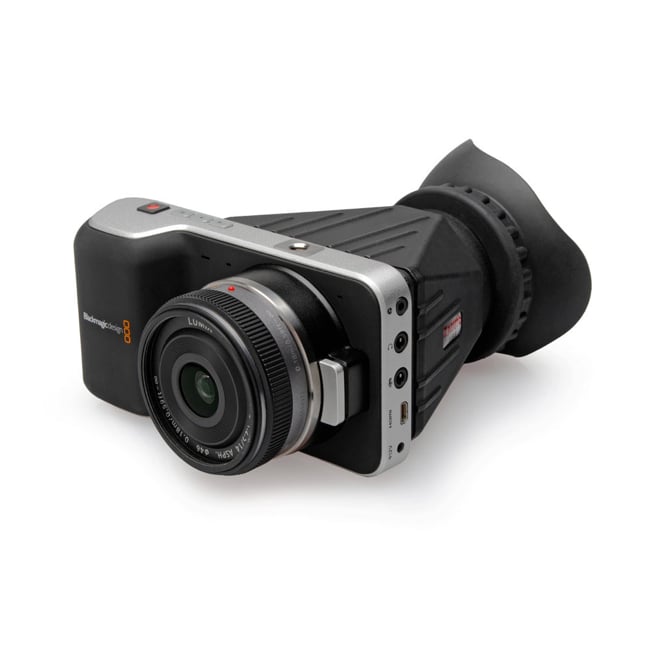
3. IRND Filters
The Pocket Cinema Camera’s native ISO of 800, means shooting outdoors can be a challenge. While high sensitivities are great for shooting indoors, when you go outside you have to stop down the lens. With the relatively small sensor, when you reach f-stops like 16 and 22, diffraction starts to rear its ugly head. The laws of physics demand that squeezing an image through such a tiny aperture results in an overall loss of resolution to the picture. In addition, stopping down increases the depth of field, which may not be the correct aesthetic choice for your shot.
In order to shoot at wider aperture outdoors, you will need Neutral Density filters, they act sort of like sunglasses for your camera, cutting down the amount of light that reaches your sensor, letting you open up your lens outside. They are available in a number of densities that cut out different amounts of light. There are even Variable ND models that use dual polarizing filters to make the density stronger and lighter in a single filter, rather than having to buy and switch out many individual ND filters.
For film these visible light ND filters work great, but digital sensors are also sensitive to some infrared (IR) light, and that can cause color shifts. The stronger the ND filter, the more IR contamination occurs. After about 3 stops of ND, you’re going to need an IR filter as well. There are companies like Tiffen that combine IR and ND filters into one filter called IRND’s, but they can add a color cast of their own. To add more confusion, one filter does not necessarily work best for all cameras, as the differences in sensors result in different color casts. Luckily there’s been a lot of people trying out lots of ND/IR solutions on the Pocket Cinema Camera for a while now. The current best solution is using multiple filters from Hoya. Putting a Hoya IR CUT filter combined with one of their PROND filters gives you the best image with the least amount of color shift.
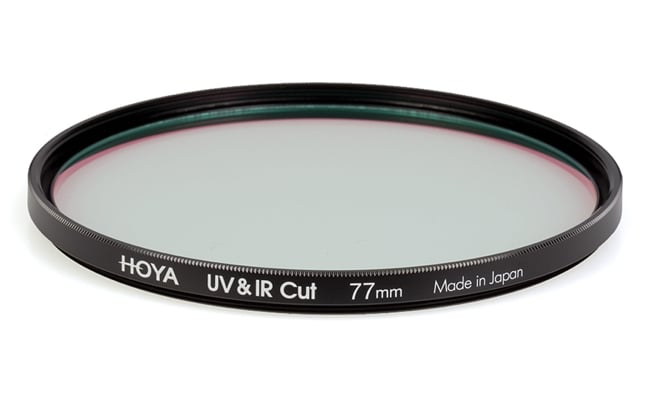
4. Fast SD Card
The Blackmagic Pocket Cinema Camera can record RAW video to SDXC cards, an impressive feat that really pushes the edge of the SDXC spec. In fact there is only one type of card that will reliably record RAW video, the Sandisk Extreme Pro SDXC card. It comes in capacities of 32 and 64GB, and you will need the minimum of two, so you can swap out the cards and still keep recording during a shoot. While these are the priciest SDXC cards on the market, if you compare them to an SxS card, or RedMag they’re an absolute bargain, and you should get them for piece of mind, even if you’re only planning to shoot ProRes.
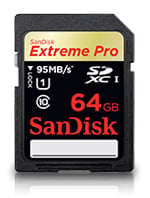
5. Power Solution
You may have noticed how fast the battery drains if you’ve been shooting with the BMPCC for any length of time. You will need some kind of power solution to get you through a days shoot. At the minimum are a half dozen or so Nikon EL-EN20 batteries. They’re cheap and ubiquitous, but you will need to be on top of the re-charging schedule, and you may want to make sure that your battery door will still open when mounted on a tripod. If you want to shoot all day uninterrupted, you will need external power. If you’re indoors feel free to use the supplied AC wall adapter that came with your camera. If you’re outside there are different options for you to use standard V-Mount broadcast batteries like the Wooden Camera V-mount Pocket, or the Switronix Pocket Base that lets you use 2 additional EL-EN20 batteries in addition to the one in the camera. That gives you a total of 3 batteries that are hot-swappable.
Adding these accessories to your Blackmagic Pocket Cinema Camera fills those production gaps left from buying just a bare camera and a lens, and unlocks the full quality and usability that a workhorse production camera demands.
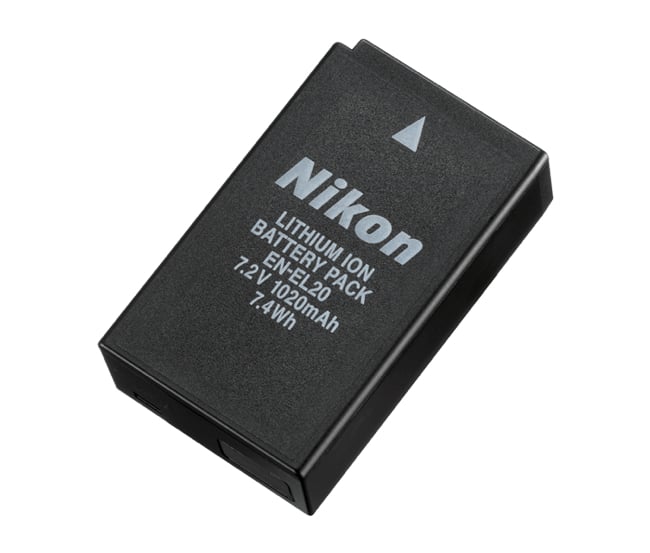
Tags: Production


Comments